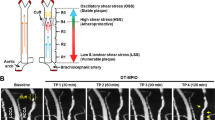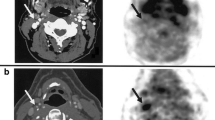Abstract
MRI is well suited for imaging vascular disease as it provides excellent soft tissue contrast and spatial resolution of the vessel wall. By generating potent contrast effects, iron oxide particles further enhance the ability of MRI to deliver functional information in a range of vascular syndromes. Larger microparticles of iron oxide (MPIO) generate sufficient contrast to enable detection of low-abundance vascular targets in vivo. Ligand-conjugated MPIO confer molecular specificity, facilitating molecular imaging of a range of specific endovascular targets. This review discusses the application of iron oxide particles in the molecular imaging of a variety of vascular syndromes. In particular, ligand-conjugated MPIO have been used for targeted molecular imaging in experimental models of atherosclerosis, thrombosis, and tissue ischemia syndromes. This provides a platform for vascular molecular imaging that could accelerate diagnosis, characterize disease progression, and measure response to treatment in a clinical setting.

Similar content being viewed by others
References
Papers of particular interest, published recently, have been highlighted as: • Of importance, •• Of major importance
Choudhury RP, Fuster V, Fayad ZA.: Molecular, cellular and functional imaging of atherothrombosis. Nat Rev Drug Discov 2004, 3:913-25.
Rudd JH, Warburton EA, Fryer TD, et al.: Imaging atherosclerotic plaque inflammation with [18F]-fluorodeoxyglucose positron emission tomography. Circulation 2002, 105:2708-11.
Toussaint JF, LaMuraglia GM, Southern JF, et al.: Magnetic resonance images lipid, fibrous, calcified, haemorrhagic, and thrombotic components of human atherosclerosis in vivo. Circulation 1996, 94:932-938.
Hatsukami TS, Ross R, Polissar NL, Yuan C.: Visualisation of fibrous cap thickness and rupture in human atherosclerotic carotid plaque in vivo with high-resolution magnetic resonance imaging. Circulation 2000, 101:2503-2509.
Grossman RI, Braffman BH, Brorson JR et al.: Multiple sclerosis: Serial study of gadolinium-enhanced MR imaging. Radiology 1988, 169:117-122.
Lipinski MJ, Amirbekian V, Frias JC et al.: MRI to detect atherosclerosis with gadolinium-containing immunomicelles targeting the macrophage scavenger receptor. Magnetic Resonance in Medicine 2006, 56:601-610.
Amirbekian V, Lipinski MJ, Briley-Saebo KC et al.: Detecting and assessing macrophages in vivo to evaluate atherosclerosis noninvasively using molecular MRI. Proc Natl Acad Sci USA 2007, 104:961-966.
Yu X, Song SK, Chen J et al.: High resolution MRI characterisation of human thrombus using a novel fibrin-targeted paramagnetic nanoparticle contrast agent. Magn Reson Med 2000, 44:867-72.
Sipkins DA, Cheresh DA, Kazemi et al.: Detection of tumor angiogenesis in vivo by alphaVbeta3-targeted magnetic resonance imaging. Nature Medicine 1998, 4:623-626.
Mendonca Dias MH, Lauterbur PC.: Ferromagnetic particles as contrast agents for magnetic resonance imaging of liver and spleen. Magn Reson Med 1986, 3:328-30.
Renshaw PF, Owen CS, McLaughlin AC et al.: Ferromagnetic contrast agents: a new approach. Magn Reson Med 1986, 3:217-25.
Kooi ME, Cappendijk VC, Cleutjens KB et al.: Accumulation of ultrasmall superparamagnetic particles of iron oxide in human atherosclerotic plaques can be detected by in vivo magnetic resonance imaging. Circulation 2003, 107:2453-2458.
Ruehm SG, Corot C, Vogt P et al.: Magnetic resonance imaging of atherosclerotic plaque with ultrasmall particles of iron oxide in hyperlipidaemic rabbits. Circulation 2001, 103:415-422.
Schmitz SA, Coupland SE, Gust R et al.: Superparamagnetic iron-oxide enhanced MRI of atherosclerotic plaques in Watanabe hereditable hyperlipidaemic rabbits. Invest Radiol 2000, 35:460-471.
Trivedi RA, Mallawarachi C, U-King-IM J et al.: Identifying inflamed carotid plaques using in vivo USPIO-enhanced MR Imaging to label plaque macrophages. Arterioscler Thromb Vasc Biol 2006, 26:1601-1606.
Shapiro EM, Skrtic S, Sharer K et al.: MRI detection of single particles for cellular imaging. Proc Natl Acad Sci USA 2004, 101:10901-10906.
Wu YL, Ye Q, Foley LM et al.: In situ labelling of immune cells with iron oxide particles: an approach to detect organ rejection by cellular MRI. Proc Natl Acad Sci USA 2006, 103:1852-1857.
• Ye Q, Wu YL, Foley LM et al.: Longitudinal tracking of recipient macrophages in a rat chronic cardiac allograft rejection model with non-invasive magnetic resonance imaging using micrometer-sized paramagnetic iron oxide particles. Circulation 2008, 118:149-156. This article details use of MPIO in cellular imaging of macrophage recruitment in a model of chronic cardiac allograft rejection.
Yang Y, Yang Y, Yanasak N et al.: Temporal and non-invasive monitoring of inflammatory-cell infiltration to myocardial infarction sites using micrometer-sized iron oxide particles. Magn Reson Med 2010, 63:33-40.
Montet-Abou K, Darie J, Hyacinthe J et al.: In vivo labelling of resting monocytes in the reticuloendothelial system with fluorescent iron oxide nanoparticles prior to injury reveals that they are mobilized to infarcted myocardium. Eur Heart J 2010, 31:1410-1420.
•• McAteer MA, Sibson NR, von zur Muhlen C et al.: In vivo magnetic resonance imaging of acute brain inflammation using microparticles of iron oxide. Nat Med 2007, 13:1253-1258. This article describes the application of VCAM-1 antibody-conjugated MPIO for MRI of acute inflammation in vivo.
Choudhury RP.: Atherosclerosis and thrombosis: identification of targets for magnetic resonance imaging. Top Magn Reson Imaging 2007, 18:319-27.
Galkina E, Ley K.: Leukocyte influx in atherosclerosis. Curr Drug Targets 2007, 8:1239-48.
Cybulsky MI, Iiyama K, Li H et al.: A major role for VCAM-1, but not ICAM-1, in early atherosclerosis. J Clin Invest 2001, 107:1255-62.
•• McAteer MA, Schneider JE, Ali ZA, et al.: Magnetic resonance imaging of endothelial adhesion molecules in mouse atherosclerosis using dual-targeted microparticles of iron oxide. Atheroscler Thromb Vasc Biol 2008, 28:77-83. This article describes the application of dual ligand–conjugated MPIO for imaging advanced atherosclerosis on MRI.
Iiyama K, Hajra L, Iiyama M et al.: Patterns of vascular cell adhesion molecule-1 and intercellular adhesion molecule-1 expression in rabbit and mouse atherosclerotic lesions and at sites predisposed to lesion formation. Circ Res 1999, 85:199-207.
Flacke S, Fischer S, Scott MJ et al.: Novel MRI contrast agent for molecular imaging of fibrin: implications for detecting vulnerable plaques. Circulation 2001, 104:1280-1285.
Botnar RM, Perez AS, Witte S et al.: In vivo molecular imaging of acute and subacute thrombosis using a fibrin-binding magnetic resonance imaging contrast agent. Circulation 2004, 109:2023-2029.
Langer HF, Gawaz M.: Platelet-vessel wall interactions in atherosclerotic disease. Thromb Haemost 2008, 99:480-6
Gawaz M, Langer HF, May AE.: Platelets in inflammation and atherogenesis. J Clin Invest 2005, 115:3378-84.
• von zur Muhlen C, Peter K, Ali ZA, et al.: Visualisation of activated platelets by targeted magnetic resonance imaging utilizing conformation-specific antibodies against glycoprotein IIb/IIIa. J Vasc Res 2009, 46:6-14. This article details development and application of an MPIO imaging probe that specifically targets activated platelets and is detectable on MRI.
Stoll P, Bassler N, Hagemeyer CE et al.: Targeting ligand-induced binding sites on GPIIb/IIIa via single-chain antibody allows effective anticoagulation without bleeding time prolongation. Arterioscler Thromb Vasc Biol 2007, 27:1206-12.
Schwarz M, Meade G, Stoll P et al.: Conformation-specific blockade of the integrin GPIIb/IIIa: a novel antiplatelet strategy that selectively targets activated platelets. Circ Res 2006, 99:25-33.
von zur Muhlen C, von Elverfeldt D, Moeller JA et al.: Magnetic resonance imaging contrast agent targeted toward activated platelets allows in vivo detection of thrombosis and monitoring of thrombolysis. Circulation 2008, 118:258-67.
von zur Muhlen C, von Elverfeldt D, Choudhury RP et al.: Functionalized magnetic resonance contrast agent selectively binds to glycoprotein IIb/IIIa on activated human platelets under flow conditions and is detectable at clinically relevant field strengths. Mol Imaging 2008, 7:59-67.
Yellon DM, Hausenloy DJ.: Myocardial reperfusion injury. N Eng J Med 2007, 357:1121-35.
Frijins CJ, Kappelle LJ.: Inflammatory cell adhesion molecules in ischaemic cerebrovascular disease. Stroke 2002, 33:2115-22.
Okada Y, Copeland BR, Mori E et al.: P-selectin and intercellular adhesion molecule-1 expression after focal brain ischemia and reperfusion. Stroke 1994, 25:202-11.
Kurose I, Anderson DC, Miyasaka M et al.: Molecular determinants of reperfusion-induced leukocyte adhesion and vascular protein leakage. Circ Res 1994, 74:336-43.
• Akhtar AM, Schneider JE, Chapman SJ et al.: In vivo quantification of VCAM-1 expression in renal ischaemia reperfusion injury using non-invasive magnetic resonance molecular imaging. PLoS ONE 2010. Published on-line. PLoS ONE 5(9): e12800. doi:10.1371/journal.pone.0012800. This article describes the application of VCAM-1 antibody-conjugated MPIO for imaging renal ischemia reperfusion injury in vivo.
Chamorro A, Hallenbeck J.: The harms and benefits of inflammatory and immune responses in vascular disease. Stroke 2006, 37:291-293.
Kim JS.: Cytokines and adhesion molecules in stroke and related diseases. J Neurol Sci 1996, 137:69-78.
Krupinski J, Kaluza J, Kumar P et al.: Role of angiogenesis in patients with cerebral ischaemic stroke. Stroke 1994, 25:1794-98.
Castillo J, Alvarez-Sabin J, Martinez-Vila E et al.: Inflammation markers and prediction of post-stroke vascular disease recurrence: The MITICO study. J Neurol 2009, 256:217-24.
• Hoyte LC, Brooks KJ, Nagel S et al.: Molecular magnetic resonance imaging of acute vascular cell adhesion molecule-1 expression in a mouse model of cerebral ischaemia. J Cereb Blood Flow Metab 2010, 30(6):1178-87. This article describes the application of VCAM-1 antibody-conjugated MPIO for MRI of cerebral ischemia in vivo in an animal model of stroke.
Barone FC.: Ischaemic stroke intervention requires mixed cellular protection of the penumbra. Curr Opin Investig Drugs 2009, 10:220-23.
Ferrer I, Friguls B, Dalfo E et al.: Caspase-dependent and caspase-independent signalling of apoptosis in the penumbra following middle cerebral artery occlusion in the adult rat. Neuropathol Appl Neurobiol 2003, 29:472-81.
Will O, Purkayastha S, Chan C et al.: Diagnostic precision of nanoparticle-enhanced MRI for lymph-node metastases: a meta-analysis. Lancet Oncol 2006, 7:52-60.
Disclosure
No potential conflicts of interest relevant to this article were reported.
Author information
Authors and Affiliations
Corresponding author
Rights and permissions
About this article
Cite this article
Mankia, K.S., McAteer, M.A. & Choudhury, R.P. Microparticle-Based Molecular MRI of Atherosclerosis, Thrombosis, and Tissue Ischemia. Curr Cardiovasc Imaging Rep 4, 17–23 (2011). https://doi.org/10.1007/s12410-010-9059-z
Published:
Issue Date:
DOI: https://doi.org/10.1007/s12410-010-9059-z




